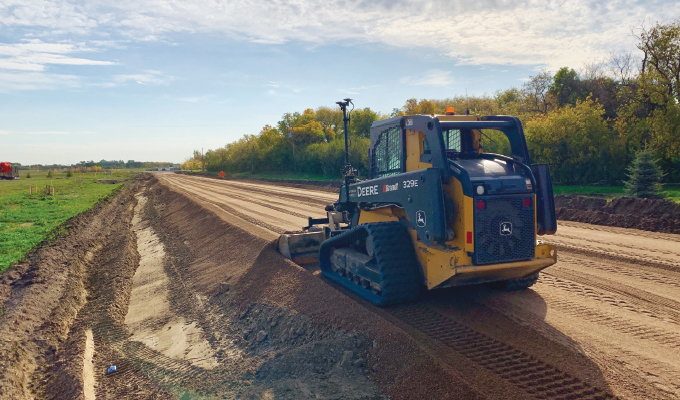Investor Darren Hagen is the owner/developer of the $2.8-million-Canadian Grasswood Estates project, a residential subdivision located in Corman Park, Saskatchewan, a suburb of Saskatoon, the largest city in the province. The 150-acre residential subdivision was created 3 years ago on vacant farmland with 42 of the planned 180 homes being constructed almost immediately. A scenic winding 6-mile road connects the properties and provides ingress and egress to the subdivision. For the first 2 years, the homeowners living in the new subdivision were driving on temporary, and in some cases, rutted roads that wound through the subdivision.
BUILDING THE ROAD
In June 2018, Hagen brought in Warman Excavating & Trenching Ltd. to build a permanent, paved road.
“Initially, our biggest challenge on the project was winning the confidence and cooperation of the homeowners who had been patiently waiting for their approximately 6-mile road to be paved,” states Jean Poirier, project manager with Warman Excavating & Trenching Ltd. “We went out of our way to assure the residents that we’ll do what we can to accommodate their needs while working hard to complete the road quickly.
STARTED USING STAKES
“For the first 2 weeks of the project we used layout stakes, which proved to be a cumbersome mistake. With the amount of resident traffic going in and out of the subdivision, we had to spend an inordinate amount of time re-staking all the ones that were run over, pulled up, or relocated because a frustrated resident wanted them out of the way.”
Poirier also learned fairly quickly that there are 38 engineers living in the subdivision, which provided an extra challenge.
“I’m an engineer too, so I know what a pain we can be in terms of wanting to know exactly what’s going on in a project,” says Poirier. “There was one engineer resident who would measure our progress each day using his own instruments. It took him a few days before he accepted that we knew what we’re doing. I wasn’t angry or insulted since that engineer and I are alike in needing to know and the desire to make certain work is completed accurately.”
DECISION TO GO STAKELESS
To move away from a staked jobsite, Poirier contacted Muaz Sheriff with Brandt Tractor Ltd., the local Topcon Positioning Systems dealer for help to create a stakeless jobsite. Sheriff helped Warman Excavating create a 3D site plan which could be used by the heavy equipment for GPS-guided machine control. The digital site model was created using Topcon Magnet Office and P3D software. Warman Excavating then had all the points and the site plan governing the progress in the field, displayed in the cabs of the GPS-governed machines.
TOPCON MACHINE CONTROL
For the project, Warman Excavating used its Komatsu D-65EX crawler dozer and a John Deere 329 compact track loader (SSL), both equipped with Topcon 3D-MC2 machine control, acquired from Brandt Tractor. The 3D-MC2 system uses MC2 inertial measurement units (IMU) sensors, which eliminates the need for receiver posts mounted on the heavy equipment blades.
“The MC2 system is designed to reduce downtime, increase productivity, reduce machine maintenance, and lower fuel cost, thus making it a good fit for the Grasswood project” Sheriff says. “It’s intended to be a dozer system, but works well on compact equipment like a skid steer loader.”
TECH MAKES THE DIFFERENCE
The project required 20,000 cubic yards of fill, 39,000 tons of sand, and 46,000 tons of chipped stone.
“Production flexibility was crucial considering residents were coming and going at any time during a 24-hour day,” Poirier says. “We needed to stop what we were working on with a moment’s notice and then pick up again after the homeowner had passed … without missing a beat.”
Sheriff was instrumental in steering them to a compact piece of equipment. A skid-steer loader, as one of the principle pieces of production equipment, made sense to accommodate the stop-and-start traffic flow as well as the road’s configuration which contained elevation changes, tight radiuses, and twists and turns through the subdivision.
Shortly after the Grasswood Estates project began, the owner altered the production timeline. The owner changed the completion deadline to a full month earlier than the original plan.
“This meant our work week became 7 days,” states Poirier. “We had to work harder and smarter; because there was no way we would miss the deadline—our reputation has been built on quality results completed on time.”
CLOSING THOUGHT
For the Warman Excavating crew, their hard work—as some might say insane production schedule—paid off. The work was completed a full week before the deadline—essentially 5 weeks ahead of the original production goal. With early completion, they safely avoided a $1,000 per day penalty for every day past the deadline. What made the difference? For Warman, it was using technology to maximize productivity.
When asked if the owner is happy with the new 6-mile paved road that serves the residents in his new residential subdivision, Poirier says: “He’s happy. In fact, he likes what we did so much that he’s hired us to do the same thing on his next residential subdivision project. Hopefully, the schedule will not be as intense.”
About the author:
Jeff Winke is a business and construction writer based in Milwaukee, Wisconsin. He can be reached through jeff_winke@yahoo.com.
Modern Contractor Solutions, March 2020
Did you enjoy this article?
Subscribe to the FREE Digital Edition of Modern Contractor Solutions magazine.



